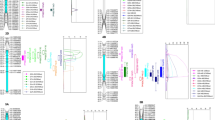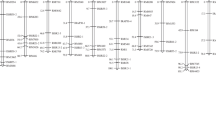Abstract
Salinity is a complex abiotic stress and understanding the physiological and genetic basis of salinity tolerance is a prerequisite for improving existing crop cultivars. Experiments were undertaken using 126 recombinant inbred lines from a cross between JG 62 (tolerant) and ICCV 2 (sensitive) to characterize traits related to seed yield differences under saline conditions and to map quantitative trait loci (QTL). The population segregated for flowering time and entries were separated into ‘early’ and ‘late’ phenology groups to undertake the analysis. In both groups seed yield varied under salinity, with seed number being the most closely related trait to yield. In contrast, seed yield was not related to 100-seed weight or flowering time. Shoot dry weight was positively correlated with seed yield in the early entries only, but had no significant relationship with seed number. The higher sensitivity to salinity of the early entries was related both to a smaller biomass and lesser seed number under saline conditions. A QTL for seed yield under saline conditions was found in linkage group 3 in the late group, and a cluster of QTL for seed yield components in linkage group 6, including a QTL for seed number which explained 37% of the variation. In contrast, no QTL for seed yield was found in the early group, but a QTL for seed number under saline conditions was found. These data indicate that salinity tolerance traits are linked to the degree of earliness in chickpea. Tolerance is determined by the success of reproductive sites in both early and late entries, which relates in part to constitutive traits, and by the capacity of maintaining growth in early-flowering lines only. This is the first report of QTL for seed yield and seed number in chickpea exposed to salinity.



Similar content being viewed by others
References
Achard P, Cheng H, De Grauwe L, Decat J, Schoutteten H, Moritz T, Van Der Straeten D, Peng J, Harberd NP (2006) Integration of plant responses to environmentally activated phytohormonal signals. Science 311:91–94
Anuradha C, Gaur PM, Pande S, Gali KK, Ganesh M, Kumar J, Varshney RK (2011) Mapping QTL for resistance to botrytis grey mould in chickpea. Euphytica. doi: 10.1007/s10681-011-0394-1 (in press)
Cho S, Jagdish Kumar J, Shultz JL, Anupama K, Tefera F, Anupama K, Tefera F, Muehlbauer FJ (2002) Mapping genes for double podding and other morphological traits in chickpea. Euphytica 128:285–292
Datta KS, Dayal J, Goswami CL (1987) Effect of salinity on growth and yield attributes of chickpea (Cicer arietinum L). Ann Biol 3:47–53
Dhingra HR, Varghese TM (1993) Flowering and male reproductive functions of chickpea (Cicer arietinum L) genotypes as affected by salinity. Biol Plant 35:447–452
Ellis RP, Forster BP, Gordon DC, Handley LL, Keith RP, Lawrence P, Meyer R, Powell W, Robinson D, Scrimgeour CM, Young G, Thomas WTB (2002) Phenotype/genotype associations for yield and salt tolerance in a barley mapping population segregating for two dwarfing genes. J Exp Bot 53:1163–1176
Flowers TJ, Gaur PM, Gowda CLL, Krishnamurthy L, Samineni S, Siddique KMH, Turner NC, Vadez V, Varshney RK, Colmer TD (2010) Salt sensitivity in chickpea. Plant Cell Environ 33:490–509
Gregorio GB, Senadhira D, Mendoza RD, Manigbas NL, Roxas JP, Guerta CQ (2002) Progress in breeding for salinity tolerance and associated abiotic stresses in rice. Field Crops Res 76:91–101
Katerji N, van Hoorn JW, Hamdy A, Mastrorilli M, Oweis T, Malhotra RS (2001) Response to soil salinity of two chickpea varieties differing in drought tolerance. Agric Water Manag 50:83–96
Kosambi DD (1944) The estimation of map distance from recombination values. Ann Eugen 12:172–175
Krishnamurthy L, Johansen C, Sethi SC (1999) Investigation of factors determining genotypic differences in seed yield of non-irrigated and irrigated chickpeas using a physiological model of yield determination. J Agron Crop Sci 183:9–17
Krishnamurthy L, Turner NC, Gaur PM, Upadhyaya HD, Varshney RK, Siddique KHM, Vadez V (2011) Consistent variation across years in salinity resistance in a diverse range of chickpea (Cicer arietinum L.) genotypes. J Agron Crop Sci. doi: 10.1111/j.1439-037X.2010.00456.x
Lander ES, Green J (1987) Construction of multilocus genetic linkage maps in human. P Nat Acade Sci USA 84:2363–2367
Lauter DJ, Munns DN (1986) Salt resistance of chickpea genotypes in solutions salinized with NaCl or Na2SO4. Plant Soil 95:271–279
Lee GJ, Boerma HR, Villagarcia MR, Zhou X, Carter TE Jr, Li Z, Gibbs MO (2004) A major QTL conditioning salt tolerance in S-100 soybean and descendent cultivars. T Appl Genet 109:1610–1619
Leport L, Turner NC, French RJ, Tennant D, Thomson BD, Siddique KHM (1998) Water relations, gas exchange and growth of cool-season grain legumes in a Mediterranean-type environment. Eur J Agron 9:295–303
Leport L, Turner NC, French RJ, Barr MD, Duda R, Davies SL, Tennant D, Siddique KHM (1999) Physiological responses of chickpea genotypes to terminal drought in a Mediterranean-type environment. Eur J Agron 11:279–291
Leport L, Turner NC, Davies SL, Siddique KHM (2006) Variation in pod production and abortion among chickpea cultivars under terminal drought. Eur J Agron 24:236–246
Mamo T, Richter C, Heiligtag B (1996) Salinity effects on the growth and ion contents of some chickpea (Cicer arietinum L) and lentil (Lens culinaris medic) varieties. J Agron Crop Sci 176:235–247
Munns R, Tester M (2008) Mechanisms of salinity tolerance. Ann Rev Plant Biol 59:651–681
Nayak SN, Zhu H, Varghese N, Choi HK, Datta S, Horres R, Jüngling R, Singh J, Kavi Kishor PB, Kahl G, Winter P, Cook DR, Varshney RK (2010) Integration of novel SSR and gene-based marker loci in the chickpea genetic map and establishment of new anchor points with Medicago truncatula genome. Theor Appl Genet 120:1415–1441
Nayyar H, Kaur S, Singh KJ, Dhir KK, Bains T (2005) Water stress-induced injury to reproductive phase in chickpea: Evaluation of stress sensitivity in wild and cultivated species in relation to abscisic acid and polyamines. J Agron Crop Sci 191:450–457
Quarrie SA, Steed A, Calestani C, Semikhodskii A, Lebreton C, Chinoy C, Steele N, Pljevljakusić D, Waterman E, Weyen J, Schondelmaier J, Habash DZ, Farmer P, Saker L, Clarkson DT, Abugalieva A, Yessimbekova M, Turuspekov Y, Abugalieva S, Tuberosa R, Sanguineti MC, Hollington PA, Aragués R, Royo A, Dodig D (2005) A high-density genetic map of hexaploid wheat (Triticum aestivum L.) from the cross Chinese Spring × SQ1 and its use to compare QTLs for grain yield across a range of environments. T Appl Genet 110:865–880
Radhika P, Gowda SJM, Kadoo NY, Mhase LB, Jamadagni BM, Sainani MN, Chandra S, Gupta VS (2007) Development of an integrated intraspecific map of chickpea (Cicer arietinum L.) using two recombinant inbred line populations. Theor Appl Genet 115:209–216
Rangasamy P (2006) World salinization with emphasis on Australia. J Exp Bot 57:1017–1023
Ren ZH, Gao JP, Li LG, Cai XL, Huang W, Chao DY, Zhu MZ, Wang ZY, Luan S, Lin HX (2005) A rice quantitative trait locus for salt tolerance encodes a sodium transporter. Nature Genet 37:1141–1146
Richards RA (1983) Should selection for yield in saline regions be made on saline or non-saline soils. Euphytica 32:431–438
Samineni S, Siddique KHM, Gaur PM, Colmer TD (2011) Salt sensitivity of the vegetative and reproductive stages in chickpea (Cicer arietinum L.): podding is a particularly sensitive stage. Environ Exp Bot 71:260–268
Saxena NP (1984) Chickpea. In: Goldworthy PR, Fisher NM (eds) The physiology of tropical field crops. Wiley, New York, pp 419–452
Serraj R, Krishnamurthy L, Upadhyaya HD (2004) Screening chickpea mini-core germplasm for tolerance to soil salinity. Int Chickpea Newsl 11:29–32
Takehisa H, Shimodate T, Fukuta Y, Ueda T, Yano M, Yamaya T, Kameya T, Sato T (2004) Identification of quantitative trait loci for plant growth of rice in paddy field flooded with salt water. Field Crops Res 89:85–95
Vadez V, Krishnamurthy L, Serraj R, Gaur PM, Upadhyaya HD, Hoisington DA, Varshney RK, Turner NC, Siddique KHM (2007) Large variation in salinity tolerance in chickpea is explained by differences in sensitivity at the reproductive stage. Field Crops Res 104:123–129
Varshney RK, Hoisington DA, Upadhyaya HD, Gaur PM, Nigam SN, Saxena K, Vadez V, Sethy NK, Bhatia S, Aruna R, Gowda MVC, Singh NK (2007) Molecular genetics and breeding of grain legume crops for the semi-arid tropics. In: Varshney RK, Tuberosa R (eds) Genomics assisted crop improvement, vol II: genomics applications in crops. Springer, Dordrecht, pp 207–242
Varshney RK, Hoisington DA, Nayak SN, Graner A (2009) Molecular plant breeding: methodology and achievements. In: Somers D, Langridge P, Gustafson PJ (eds) Methods in molecular biology: plant genomics. The Humana Press, Totowa, pp 283–304
Wang S, Basten CJ, Zeng ZB (2010) Windows QTL cartographer 2.51. Department of Statistics, North Carolina State University, Raleigh, NC. http://statgen.ncsu.edu/qtlcart/WQTLCart.htm
Winter P, Benko-Iseppon AM, Hüttel B, Ratnaparkhe M, Tullu A, Sonnante G, PfaV T, Tekeoglu M, Santra D, Sant VJ, Rajesh PN, Kahl G, Muehlbauer FJ (2000) A linkage map of the chickpea (Cicer arietinum L.) genome based on the recombinant inbred lines from a C. arietinum × C. reticulatum cross: localization of resistance genes for Fusarium races 4 and 5. T Appl Genet 101:155–1163
Acknowledgments
The work was supported by Australian Research Council LP0776586 grant and COGGO (Council of Grain Grower Organisations Ltd), from support of the Government of Japan to ICRISAT, and from support from the Indian Council of Agriculture Research (ICAR) of the Government of India. Authors are thankful for the expert technical assistance of Mr N. Jangaiah at ICRISAT.
Author information
Authors and Affiliations
Corresponding author
Electronic supplementary material
Below is the link to the electronic supplementary material.
Rights and permissions
About this article
Cite this article
Vadez, V., Krishnamurthy, L., Thudi, M. et al. Assessment of ICCV 2 × JG 62 chickpea progenies shows sensitivity of reproduction to salt stress and reveals QTL for seed yield and yield components. Mol Breeding 30, 9–21 (2012). https://doi.org/10.1007/s11032-011-9594-6
Received:
Accepted:
Published:
Issue Date:
DOI: https://doi.org/10.1007/s11032-011-9594-6




